#bigamic
Text
"The court also provided the forum for forging alliances to further interests in the localities: the court was the obvious meeting point for the 'feminine gang of three'—Alice Chaucer, Elizabeth Talbot, and Elizabeth Woodville— to whom Colin Richmond has attributed a successful campaign to wrest two manors of the Fastolf inheritance from the Pastons and into the hands of Alice Chaucer's son, the king's brother-in-law, John de la Pole. Again this was a queenly role that usually left no evidence but its political importance must not be overlooked."
J.L. Laynesmith, "The Last Medieval Queens: English Queenship 1445-1503"
#historicwomendaily#english history#elizabeth woodville#alice chaucer#elizabeth talbot#elizabeth talbot aka eleanor talbot's sister. who would have obviously known if her sister was secretly married to the King#WHY would she be willingly allied with Elizabeth Woodville if that was actually true? she would've know that EW'e marriage was bigamous#and that her queenship was false#15th century#queenship tag#my post#queue
14 notes
·
View notes
Text
Started reading the vs event from JP server and Kagari is so SO beautiful.
Only Keith makes my heart race tho 🤷♀️
2 notes
·
View notes
Text

"Convicted of bigamy in marrying Mrs. Frazer, of Highgate, while his previous wife was still living, Peter Schram was yesterday morning sentenced in Chatham by Judge Dowling to six years' imprisonment in Kingston penitentiary. Schram is alleged to have been thrice married."
- from the Hamilton Spectator. April 26, 1913. Page 4.
[AL: Schram was 52, from Simcoe, Ont., a stationary engineer, and had served a previous jail term for bigamy in the local jail. Schram was convict #F-599 at Kingston Penitentiary and worked in the engineer's gang. He was paroled in late 1914.]
#chatham#bigamy#bigamous marriage#small town ontario#rural crime#rural canada#regulation of marriage#marriage law#sentenced to the penitentiary#kingston penitentiary#crime and punishment in canada#history of crime and punishment in canada
1 note
·
View note
Text
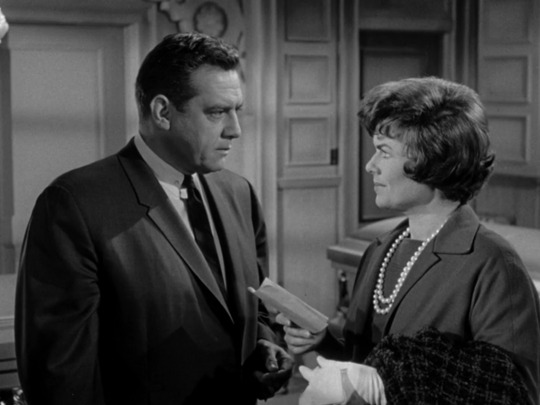
Oh my god. Perry borrowed Della's lipstick and used it to take the fingerprints of a corpse, without telling her. If I were her, I would have given him a lot more than a disgusted look, I probably would have decked him. Sir, you better start shopping for that apology gift now.
#perry mason#della street#you would think perry would be a bit more respectful of her lipstick#after all#i'm sure he enjoys it too#the case of the bigamous spouse
3 notes
·
View notes
Text
youtube
#NewsofTheTimes#eastbournemurders#HistoricalCrimeStories#bigaming#serialkillersaturdays#serialkillersdocumentaries#Youtube
1 note
·
View note
Text
youtube
#was elizabeth woodville married to edward iv?#history calling#lady eleanor butler#who was edward iv married to?#bigamous king?#fake queen?#Youtube
0 notes
Text
sorry i haven’t posted in a while, i’ve been too busy testing my knowledge on the most Obscure facts of every single u.s. president
#oh sporcle how i love you#did u know that benjamin harrison is william harrison’s grandson#and jfk was the first catholic president#i already learned that in class but still#also andrew jackson’s wife died right before he got elected president and was bigamous??#curious men they are#oh also i had no clue that rutherford b hayes is the least known president#that sounds like a lie. it probably is#i would guess like pierce or arthur or something#fillmore?? tyler?? taylor??#also james buchanan#maybe i’m just not aware of how popular every president is#misc#anyway
1 note
·
View note
Text
Asian girl play pussy in toilet and kissing with friend
Pinay homemade sex batangas viral scandal
Krissy Lynn In Wildest Toy Turns To Anal Sex
I know that my STEP MOM is a cheating wife so she let me fuck her (I cum twice: DOGGY and FACIAL)
Latin gay boy vs boys teen It is highly lucky this camera man had his
Big dicks makes boy ass bleed gay porn xxx A Juicy Reward For Elijah
Hot Latina Dancing fire
Annas Mornas milf twat romped in standing position by Jmac massive man meat
PAWG BBW Super Wet Pussy
Guy gets fucked by busty black tgirl
#plebescite#nonproscriptive#satanize#rebluff#prosthesis#たくし上げ#many-coltered#sesquialteral#cuckolded#Kosel#hump-shaped#heliofugal#caricatura#reddingite#slantly#unclearer#ouf#Winnifred#Matthaean#bigamize
1 note
·
View note
Note
Gay/lesbian solidarity is alive and well! We are married and I'm good friends with my wife's wife and you're friends with your husband's husband!
I may not steal jewels but I do believe in this bigamous marriage!
i was about to say yes yes the lavender marriage weve all seen it but that is entirely not this situation at all JKHFDJKS my wires got CROSSED!!!! we are BEARDS!!!!!!! i also typed bears i am NOT a bear sorry to disappoint
#but also bigamous just reminds me of the word bigot. hello. bigot marriage#snail mail#would you believe me if i said i almost just typed my password in instead of snail mail. i need to be put down
0 notes
Photo

Saint Thomas More
1478-1535
Feast day: June 22 (New), July 9 (Trad)
Patronage: adopted children, civil servants, court clerks, difficult marriages, large families, politicians, lawyers, and statesmen
St. Thomas More was an English lawyer, social philosopher, author, statesman and noted Renaissance humanist. He was also a counselor to Henry VIII and Lord Chancellor from October 1529 to 16 May 1532. More opposed the Protestant Reformation, in particular, the theology of Martin Luther and William Tyndale. He also wrote Utopia, published in 1516, about the political system of an ideal and imaginary island nation. More opposed the King's separation from the Catholic Church, refusing to accept him as Supreme Head of the Church of England, and what he saw as Henry's bigamous marriage to Anne Boleyn. Tried for treason, More was convicted and beheaded.
Prints, plaques & holy cards available for purchase here: (website)
114 notes
·
View notes
Text







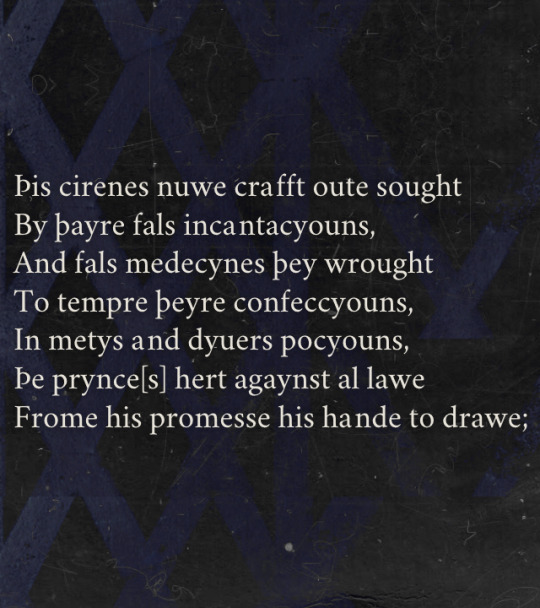

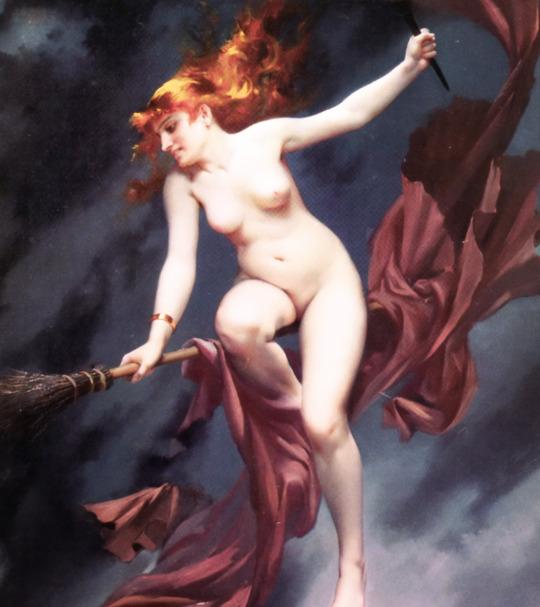
A Complaint for My Lady of Gloucester and Holland
Although the “Complaint” is focused on Jacqueline and includes a potentially subversive chorus of grieving women in support of her, Eleanor makes an oblique and threatening appearance about halfway through […] This characterization of Eleanor persists for several more stanzas, referring to “fals Circes,” and “cirens,” whose “fals incantacyouns” and “fals medecynes … / þe prynces hert agaynst al lawe / Frome his promesse his hande to drawe.” Although Eleanor was only publicly accused of witchcraft in 1441, these references in a poem generally dated to 1428 suggest that her reputation preceded that. Eleanor’s position at the heart of an adulterous (and possibly bigamous) love triangle also linked her—as it linked legendary adulteresses like Guenevere and Iseult—to witchcraft, in sharp contrast to Jacqueline, the “goodely fayre pryncesse” for whom “yong and olde [cry] in oone.” A transgression in one realm, one might say, opens a door to transgressions elsewhere. Striking too is the nature of the enchantment, that of the “chaunteresse” or “Ciren.” Although the references to mermaids and “courage serpentyne” may also recall the half-snake figure of Mélusine, the fairy ancestress of the counts of Lusignan, the repetition of “songe” and constant emphasis on voice locate Eleanor’s power elsewhere, a theme to which later depictions of her will return.
—Kavita Mudan Finn, “Tragedy, Transgression, and Women’s Voices: The cases of Margaret of Anjou and Eleanor Cobham,” Viator 47.2 (2016).
John William Waterhouse (1900), A Mermaid | John Collier (1886), Lilith With A Snake | John William Waterhouse (1892), Circe Invidiosa | Herbert James Draper (1909), Ulysses and the Sirens | Luis Ricardo Falero (1880), The Witches Sabbith
#eleanor cobham#historian: kavita mudan finn#edits#historyedit#jacqueline of hainault#humphrey duke of gloucester#medieval literature
33 notes
·
View notes
Text
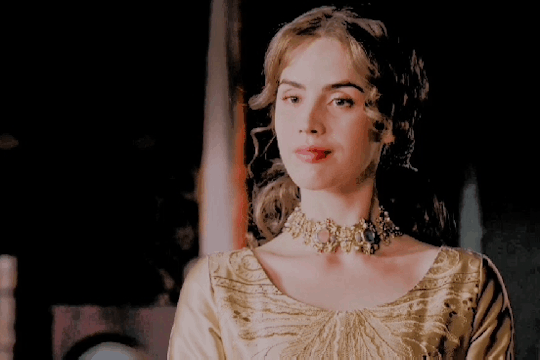
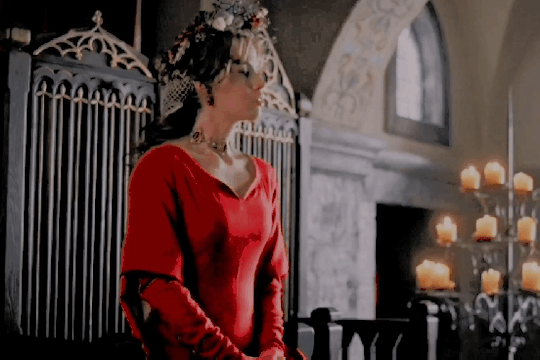




CHRISTINA ROKICZANA ( BEFORE 1330 — AFTER 1365
Christina was a Bohemian woman from townsfolk and daughter of Wenceslaus, mayor of Prague. At some point she was married to merchant Mikuláš Rokiczan, who unexpectedly died leaving her with great fortune. Thanks to her husband's connection with the King, she most likely became the lady-in-waiting at Bohemian court.
It was well known that King Casimir The Great is a womanizer and Charles of Luxembourg decided to use that fact to gain a spy in Polish court and possibly destabilise situation in Polish Kingdom. He invited Casimir to Prague in May 1356 and asked Christina to charm the man. It was successful, because Casimir shortly after brought her with him to Cracow. Christina, however, refused sleeping with him and becoming his mistress, what made Casimir marry her.
The problem was that he was already married with Adelaide of Hesse, which was sent away by him to Żarnowiec. She didn't agree to get a divorce, what made Casimir's marriage with Christina bigamous.
She stayed loyal to Charles of Luxembourg, stating in one of the latters they exchanged that as a Queen (although she was never crowned), she will make sure to take care of his interests and “being there [in Cracow], thanks to him, he can trust her as if they were still personally in the city of Prague”.
At some point Christina's and Casimir's relationship fell out and there are two theories about what happened — one of them says that Christina was suffering from hair loss and scabies and Casimir found out about that from one of his servants, whereas the other one says that Casimir was mad at her after Christina ordered to burn the peasant house, because it blocked a view of Wawel Castle.
It is known that Christina was still in Cracow when King Casimir married his fourth wife, Jadwiga of Sagan. According to the legend, she was burried in the garden of Łobzów residence, which Casimir builded for her.
16 notes
·
View notes
Photo
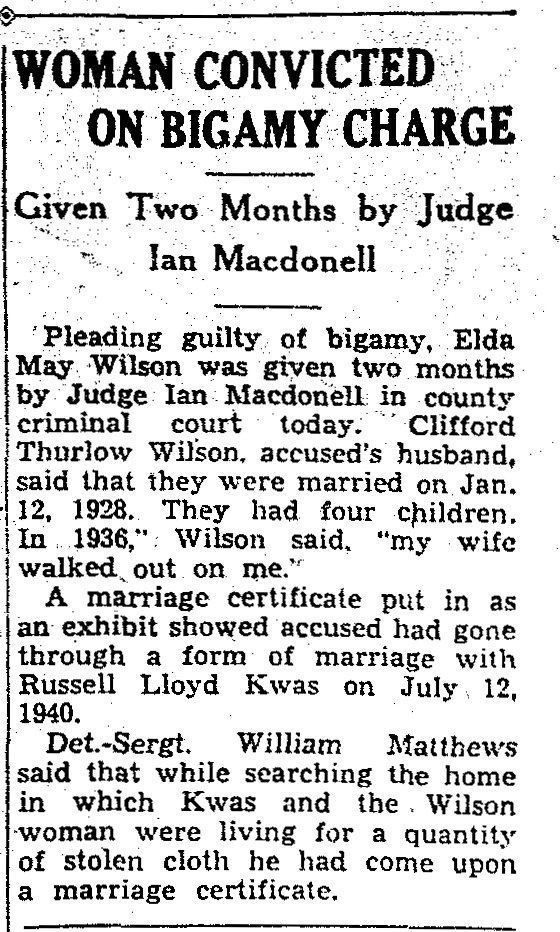
“Woman Convicted On Bigamy Charge,” Toronto Star. April 22, 1941. Page 2.
----
Given Two Months by Judge Ian Macdonell
-----
Pleading guilty of bigamy, Elda May Wilson was given two months by Judge Ian Macdonnell in county criminal court today. Clifford Thurlow Wilson, accused’s husband, said that they were married on Jan. 12, 1928. They had four children. ‘In 1936,’ Wilson said, ‘my wife walked out on me.’
A marriage certificate put in as an exhibit showed accused had gone through a form of marriage with Russell Lloyd Kwas on July 12, 1940.
Det.-Sergt. William Matthews said that while searching the home in which Kwas and the Wilson woman were living for a quantity of stolen cloth he had come upon a marriage certificate.
#toronto#county police court#bigamy#bigamous marriage#regulation of marriage#marriage#marriage law#regulation of divorce#abandoning your children#runaway wife#police search#canada during world war 2#theft#crime and punishment in canada#history of crime and punishment in canada#sentenced to prison#mercer reformatory
1 note
·
View note
Text
Anne of the Thousand Days Review: Part 1
Alright, so I got around to writing this review, and boy do I have some hot takes! Fair warning, though; this is so long I'll need to post this in two parts.
“For six years, this year, and this, and this, and this, I did not love him. And then I did. Then I was his. I can count the days I was his in hundreds … In all one thousand days. Just a thousand. strange. And of those thousand, one when we were both in love, only one, when our loves met and overlapped and were both mine and his. And when I no longer hated him, he began to hate me.”

Where do I even begin with this review? I disliked this movie when I first watched it, and after a rewatch, I still dislike it. Anne of the Thousand Days is a tedious slog of a movie which somehow both has a fundamentally weird premise and forgets its own premise at times, especially in its marketing. The poster for this movie claimed that it showed “the most passionate and shocking love story in history!” As we’ll see, though, it’s hard to claim this depiction of Henry and Anne have a grand love affair when they only mutually love each other, at least in Anne’s telling, for one day.

Anne of the Thousand Days started as a Broadway play in 1948, written by American playwright Maxwell Anderson. With Rex Harrison as Henry VIII and Joyce Redman as Anne Boleyn, the play was a critical and commercial success, running for nearly 300 shows. However, as it dealt with themes of adultery, illegitimacy, and incest, Anne of the Thousand Days ran afoul of the Hays Code, so it took over two decades to be adapted into a movie. Most of the blank verse of the play was removed, many scenes were expanded into two, three, or four, and Anne was given a monologue about Elizabeth’s future greatness to shout at Henry in the Tower. Richard Burton was cast as Henry, and the virtually unknown French-Canadian actress Genevieve Bujold was cast as Anne. Burton’s wife Elizabeth Taylor feared the two were having an affair, so she managed to obtain a cameo to keep an eye on them. Taylor had actually lobbied for the role of Anne, but at 37, she was deemed too old for Anne, who (following the scholarship of the time) aged from 18 to 29 over the course of the film. One can only wonder…

The movie follows the basic outlines of history, with a heavy emphasis on “outlines”. The opening scene is of Henry agonizing whether to sign Anne’s death warrant, as we soon transition into a palace ball where Henry falls for the vivacious and charming Anne as his sober, pious wife Catherine of Aragon despairingly looks on. He orders his chief minister, Cardinal Wolsey, to break up Anne’s relationship with the “Northern clodhopper” Harry Percy, much to her fury. She vigorously resists Henry’s advances, her resolve only strengthened by her pregnant sister Mary, who gave in to Henry and now carries his child. Mary prophetically warns, “The moment you’re conquered, he’ll walk away.” Despite Anne’s utter refusal to return his feelings, Henry continues to “love” (yes, the quotes are necessary) Anne, and eventually proposes divorcing Catherine and making Anne queen. She accepts, but unfortunately, political circumstances abroad combine to make it clear that the Pope will not grant Henry a divorce. Having fired Wolsey for his failure to get the divorce, and encouraged by his new chief minister Thomas Cromwell (and to a lesser extent, Anne) to break with Rome to get his way, Henry does so. After a tense confrontation, Anne finally tells Henry that she loves him, and they sleep together; she soon becomes pregnant and they’re married in a shotgun, bigamous wedding.

Anne is reviled at the coronation, but despite Henry’s hopes and Anne’s promises, she gives birth to a daughter, Elizabeth. Henry is furious and his eye begins to wander towards Anne’s lady-in-waiting Jane Seymour. Anne is furious and demands that Henry make everyone swear an oath recognizing their daughter as his legitimate heir on pain of death, leading to the execution of Sir Thomas More. Anne promptly miscarries a boy and Henry, believing his marriage accursed, orders Cromwell to find a way out. Cromwell soon trumps up charges of adultery with five men, incest with her brother George, and treason, which lead to Anne’s arrest. At her trial, though, Henry suddenly (and ahistorically) bursts in and manages to get the only one of the five who confessed to admit he lied under torture. Henry is still unsure of whether Anne is guilty, and he confronts her in the Tower. Anne utterly refuses to agree to an annulment, even if it means her death, and lies to Henry to hurt his manhood, declaring that she cheated on him with countless men, finding them far better lovers. For good measure, she then proclaims, “Elizabeth shall be a greater queen than any king of yours. She shall rule a greater England than you could ever have built! Yes - my Elizabeth shall be queen. And my blood will have been well-spent.” Henry promptly signs her death warrant and Anne is beheaded by a French swordsman, the movie ending with a shot of the toddler Elizabeth walking towards her destiny.

Incredibly, I did like some stuff about this movie. The costumes, designed by Margaret Furse, are exquisite and mostly accurate; if nothing else, this movie deserved its Best Costume Design Oscar. Even the fact that Genevieve Bujold’s French hoods nearly always lack a proper veil doesn’t matter, in my opinion, since she manages to pull it off. The coronation procession was absolutely stunning, and the recreation of the Tower of London is incredible; they really minimized the distance between Tower Green and St Peter ad Vincula, though. Despite not using surviving Tudor pieces, the score, composed by Georges Delerue, manages to evoke the period really well.
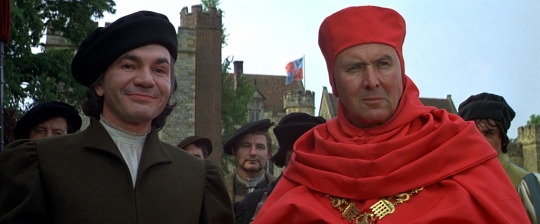
Concerning the performances, I loved Anthony Quayle’s depiction of Cardinal Wolsey, as he goes from a self-assured, powerful man to a broken, fallen minister. His final scene is heartbreaking, and Quayle humanizes him throughout; even when he breaks up Anne and Harry Percy, he doesn’t seem thoughtlessly cruel. John Colicos’ portrayal of Cromwell as “a man without scruple” is a delightfully villainous characterization, a schemer who owns up to his villainy and revels in manipulation.
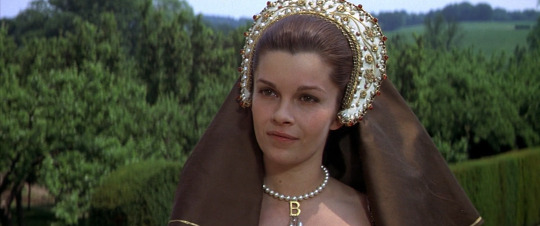
A review of Anne of the Thousand Days, of course, would be incomplete without a discussion of Genevieve Bujold’s Anne Boleyn. While not one of my top three favorite Anne Boleyn portrayals (for the record, Natalie Dormer, Dorothy Tutin, and Claire Foy), Bujold does a good job with Anne. She compellingly portrays Anne’s growth (and increasing ruthlessness) from a lovestruck teenager to a fiercely protective mother, as you can see her grow and harden over the course of the movie. She also captures Anne’s boldness and vivacity of spirit well, although sometimes to the point of straining credulity. Would the real Anne have maintained Henry’s love if she told him at the start of their relationship, “You’re spoiled and vengeful and bloody. Your poetry is sour and your music worse. You make love as you eat - with a great deal of noise and no subtlety”? It seems very unlikely. Anne’s frank declaration to Harry Percy that she’s not been a virgin for a long time additionally seems very incongruous with the historical Anne. Bujold’s acting, too, sometimes feels not just theatrical, but overly artificial and overdone, particularly when she has to express anger. Still, the fact that it is hard to imagine this Anne captivating Henry for seven years is not Bujold’s fault - she performs well the script as written - but that of the writers.
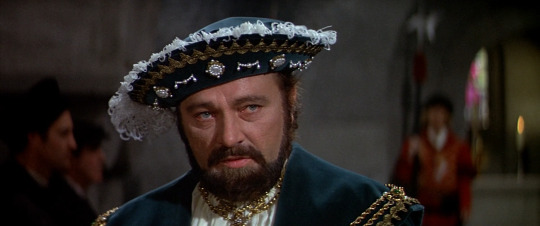
Unfortunately, this is the part of the review where I must tackle the things I disliked about this film. Equally unfortunately, there are quite a lot of them. The elephant in the room is Richard Burton’s depiction of Henry. In both history and popular depictions, Henry was and is the center of his court, someone who shifted from passionately loving Anne to furiously ordering her death on false charges; in any depiction of Anne, he is the other main character. Put bluntly, Richard Burton gives perhaps one of the creepiest portrayals of Henry VIII I’ve ever seen. While not worse than Ray Winstone’s portrayal of Henry as a marital rapist, Burton portrays Henry as a serial sexual harasser and predator. He combines the real Henry’s unshakeable belief in his own self-righteousness with a seedy lustfulness which will stop at nothing, not even claiming he’s only sexually potent with the woman in question, to get into a woman’s bed. There is little trace in this portrayal of Henry’s intellectual or cultural pursuits, and even the times when he exhibits bonhomie feel forced and fake. Furthermore, at only 5’8, Richard Burton is half a foot shorter than the real Henry, meaning he lacks the physical towering presence of the real man; he thus doesn’t physically stand out from his courtiers. In fact, Anthony Quayle as Wolsey is two inches taller than Burton; a screen Henry ought to tower above his courtiers, not vice versa!

Anne of the Thousand Days also completely misunderstands the history of the period, changing it in ways that not only make no sense plot-wise, but which indicate the writers genuinely did not understand the period. Some inaccuracies stem from changing historiography - despite being named after Anne Boleyn, the movie portrays a less politically active Anne than more recent depictions like The Tudors and Wolf Hall. However, this lack of emphasis was the result of the historiography of the time tending to minimize Anne as a political figure; only in 1986 with Eric Ives’ seminal biography of Anne would attitudes change. The inaccuracies I object to are ones which betray a lack of understanding of the basic nature of the history. I’ve already mentioned one of these inaccuracies (Anne admitting to Harry Percy that she’s not a virgin), but there’s several others. For example, Henry is seriously conflicted about breaking with Rome, stating that it would mean “everlasting damnation” and result in his soul being cast into Hell. However, this fundamentally misunderstands the real Henry’s character. When he decided on a course of action, it was not only incredibly hard to dissuade Henry from it, but he often became increasingly convinced of his own self-righteousness. As a pious early modern king, Henry would not have broken with Rome had he harbored as many doubts about its morality as he does in Anne of the Thousand Days.
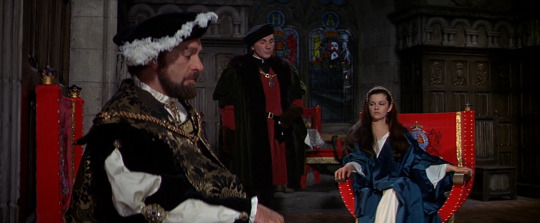
Moreover, the Act of Succession in the movie is passed only after Anne agrees to bring Jane Seymour back to court from a (fictional) exile in Northumberland. Henry himself states that “One daughter is much like another. I care not who’s named bastard when I’m dead.” As this Anne points out, this version of Henry is declining to enshrine their daughter’s legitimacy in law so he can sleep with another woman. Unsurprisingly, this did not happen in real life; the real Henry, no matter how much he wanted a son, would not have shot himself in the foot by doing this! To not pass the Act of Succession wouldn’t just harm Elizabeth, but any children, including a son, he had by Anne; Elizabeth, after all, was only heir in lieu of any sons. These are serious departures which go beyond artistic license and veer into a real lack of historical comprehension.
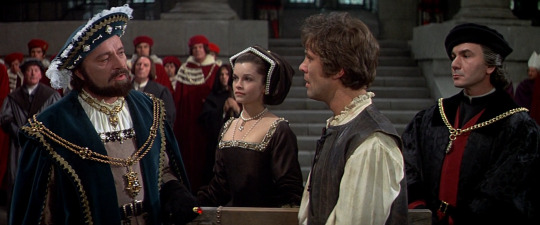
The biggest (and most absurd) inaccuracy, though, comes in Anne’s trial and resulting confrontation with Henry in the Tower. First, Anne is allowed to cross-examine Smeaton, who is brought in, along with her brother George, during the course of the trial. But this greatly downplays just how rigged the real Anne’s trial was, as in real life, no witnesses were called. Even if they had, it is incredibly unlikely Norfolk, who hated his niece in history, would have let her cross-examine them. But then, any semblance of accuracy, realism, or even sense is sacrificed wholly on the altar of drama as Henry himself enters and gets Smeaton to confess that he’s innocent. If this had happened, there would be no reason for Henry to execute him, like Burton’s version promises he’ll do. Moreover, as Smeaton was the only person (both in history and the film) who confessed, retracting his confession would mean there were no witnesses, which would have torpedoed the government’s case against Anne and the men. But Henry does this and then proceeds to mutter, “And yet… it could be true,” which is only explicable in the film if he genuinely thinks Anne is guilty of adultery. The problem is that Anne has never flirted with any of the men on screen; she’s never talked to the ones aside from her brother at all! This means that the accusations of adultery come out of left field, a failure of writing which leaves the viewer wondering where on earth that came from.
PART 2 HERE:
#tudor era#anne boleyn#anne of the thousand days#genevieve bujold#henry viii#richard burton#catherine of aragon#katherine of aragon#jane seymour#elizabeth i#the tudors#I have so much to say about this movie#but it's just not good IMO#Genevieve Bujold Anthony Quayle and John Colicos#as Anne Wolsey and Cromwell#cannot save this movie#tudorerasource#thomas wolsey#thomas cromwell
18 notes
·
View notes
Note
Prompt
Rwby
Ruby x Ren x Nora
Ruby introduced her partners to her Dad and uncle but forgot that Yang doesn't know about Ren and Nora dating her Little sister
Ruby: Dad. Uncle. Meet my boyfriend and girlfriend, Ren Lie and Nora Valkyrie.
Nora/Ren: Hello!/Hi Mr.Xiao Long, Mr.Branwen.
Taiyang/Qrow: *Greeting Politely/Curtly the bigamous couple* Hello/Hi….
Yang who was unaware her sister was dating Nora and Ren was openly gawking in complete and utter disbelief.
Yang: Ayo! What the actual fuc—
18 notes
·
View notes
Note
TYPE: Prompt
AU: Original AU, MHA AU: Older AU
FANDOM: My Hero Academia
SUMMARY: Izuku finally proposed to his two longtime girlfriends, Ochaco and Melissa to be his lawful wives on the day he have becom the Japanese Pro.Hero #1
THEME/KINK: Marriage Proposal, Bigamy, M/F/F Threesome, Wholesome
"Ochaco Uraraka," Izuku Midoirya said as he got down on one knee, holding a small, lime box in his right hand. "Melissa Shield," Deku proceeds to open the box; revealing a pair of golden rings with diamonds on them. "Will you marry me?"
The two women gazed at their boyfriend, who they were in a bigamous relationship with. Melissa covered her lips with both hands as tears of joy swell up in her eyes, meanwhile, Ochako felt her face growing hot; similar to her early days in U.A. High. Ever since Izuku and Ochako graduated, they decided to go into hero work, joining and going up the ranks of Pro Heroes. Sometime after graduation, they met Melissa Shield once again; who not only agreed to fix both Deku and Uravity's gear but join in on their relationship. Now, Midoriya found himself as the Number One Pro Hero, becoming a Symbol of their generation of Heroes.
"Yes," Ochaco said, glomping her boyfriend with full joy. "Deku, yes!"
"Of course, Deku," the American Inventor joins in on the hug, kissing the freckled man and then the brunette's cheek. "We'll marry you!"
Izuku felt his own cheeks turning red, similar to the shade of their fellow hero Red Riot. Midoriya felt happy, with the two women he loved so much. He had to inform his mom about the proposal, who fully supported the relationship. The One for All User kissed both of his beloveds, who would soon be his wives.
#answer#answered#answer post#answer posting#answer prompt#my hero academia#boku no hero acedamia#bnha au#mha au#future au#izuku midoriya#midoriya izuku#deku#ochaco uraraka#uraraka ochako#uravity#melissa shield#izuocha#dekuravity#dekulissa#bigamy#wholesome#marriage proposal
31 notes
·
View notes